From Painting to Digital 3D Art – Part 2
September is the last month of the grant I received from The Finnish Cultural Foundation. It’s time to show you the final virtual reality artwork and share more about my journey from painting to creating digital 3D art.
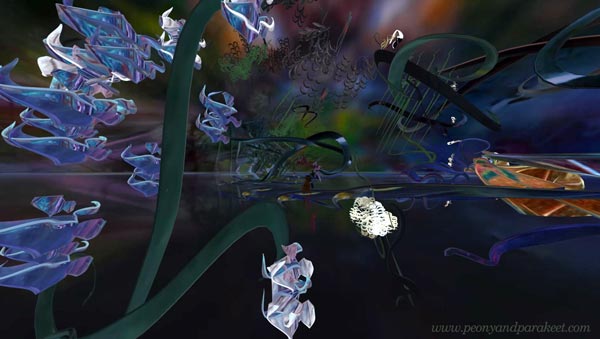
This week’s video is a sequel to the video “From Painting to Digital 3D Art” which was published in April this year.
Finished Virtual Reality Artwork – Watch the video!
In this second video, you continue to see how I transferred the visual and expressive language of my paintings into a 3-dimensional digital format. All this includes adding movement, sounds, and interaction. It’s a pity that you can’t experience my VR artwork with virtual glasses and hand controllers, but I have made all kinds of recordings to deliver the experience at least partly.
I hope you enjoy this video that not only presents the VR artwork called “Unknown Land,” but also talks about painting and developing a stronger artistic vision.
This is one of the biggest projects that I have had, and it feels sad that it’s now coming to an end. I seek opportunities to display my virtual reality artwork, and hope to have a private exhibition in the near future that has both my paintings and digital motion art.
Integrate!
My word for this year has been “Integrate.” As I said in the video: I will continue to draw, paint, model, code, and compose. One activity doesn’t exclude another. I hope you will continue following my journey no matter what I create, and I hope to inspire you in one way or another. In art, we are always heading to an unknown land – you never know what comes up next and how it will change your life! And while we go to new areas, it’s also good to integrate – to save and not abandon – everything we have created so far.
What to Create with Colored Pencils? – Watch the Video!
This week I have a short inspirational video for you. I wanted to make a video that I can share on Instagram, so this has different portions than my videos usually are. You can watch it bigger by pressing the last icon on the menubar below the video.
Most of these drawings are made with regular colored pencils (or crayons as some call them) and some with watercolor pencils. I love both.
Coloring Freely on Blank Paper – Simple Start!
I am an advocate for coloring freely – starting with blank paper, adding colors on top of each other, and getting excited about what comes up. This doesn’t have to be anything difficult. Here’s an old picture from 2015 that I still find inspiring. You can illustrate your journaling with freely colored boxes.
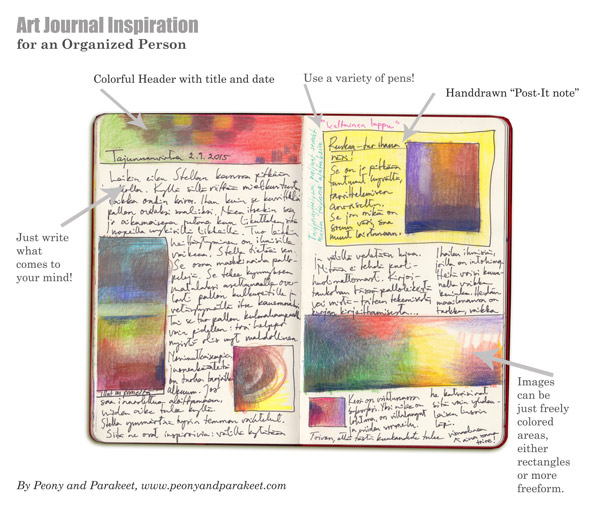
Children draw freely with colored pencils, but when they grow up and become “colored pencil artists” they need all kinds of references to get started. References are great for learning some techniques, but they don’t make anyone an artist. A big part of art is in our mind – how we open up and how we allow ourselves to break boundaries.
Growing Your Skills
My love for colored pencils is based on a promise that I have made for my inner child: I will color for you and help others to color for theirs. So even if I make oil paintings and media art too, colored pencils always have a special place in my heart.

So, welcome to my courses to improve your skills and expand your artistic thinking!
P.S. You can still sign up for Joyful Coloring!
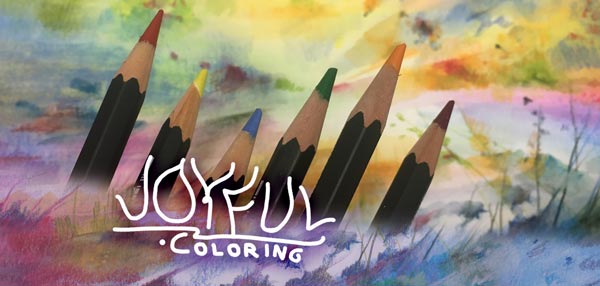
“Start Small”
In the spirit of “Start small”, have you tried this?
Draw lines and color the shapes! Art can be this simple.
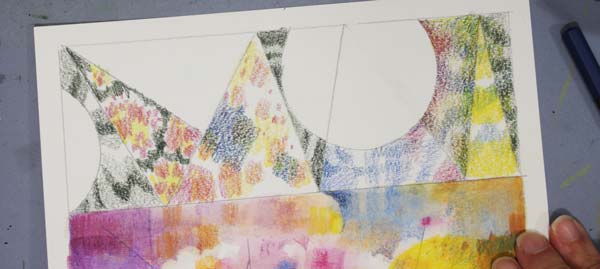
But isn’t it so, that everything just flows when you have the inspiration, and when you don’t, even a simple exercise (picked from the new course Joyful Coloring) can feel tedious.
Browsing for inspiration is never quite the same as participating in a course.
My goal in Joyful Coloring is not only to widen your mind about how you can create
but also to keep your inspiration level up.
Yes, we “start small” but with inspiration, we can also do bigger things.
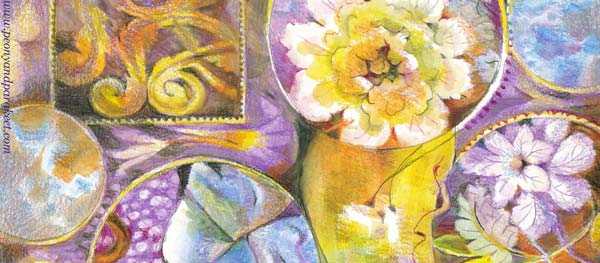
Watercolor pencils feed inspiration because they make coloring faster.
Joyful Coloring
Come with me to start small, and then create landscapes and seascapes, ornamental flowers, colorful fantasies, and modular magic.

Joyful Coloring – The new course begins on Sept 16! >> Sign up Now!
Last Bloom – Watercolor Pencil Inspiration
This week we celebrate watercolor pencils and the lifecycle of flowers. I hope this post fills you with watercolor pencil inspiration!
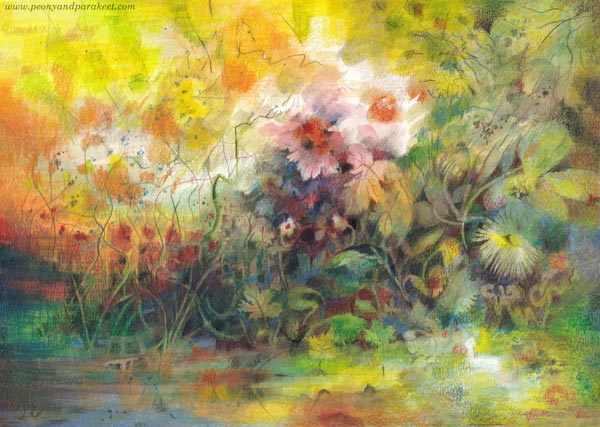
We in Finland have had a warm fall and many flowers are still blooming, even though it is already September. It inspired me to use yellows and oranges, which I love anyway.
Comforting Watercolor Pencil Inspiration
Lately, I’ve been editing videos for the upcoming course Joyful Coloring, which I recorded for the most part in the summer. I don’t know if the teacher can say it herself, the students decide that, but the videos are so inspiring!
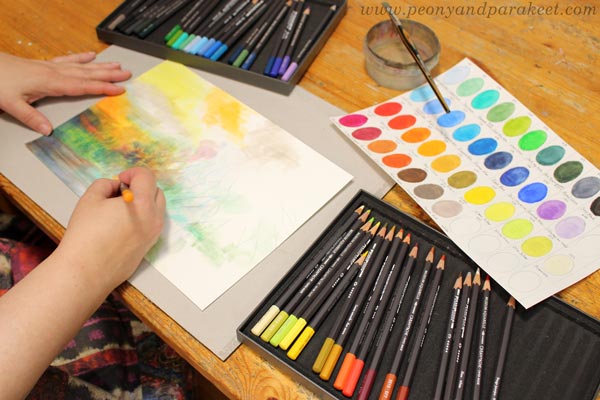
So watercolor pencils are really calling me now. I bought 20 more when I found them quite inexpensively, even though they are a good brand: Caran d’Ache Museum Aquarelle. And I also bought more paper – Fabriano Accademia Drawing Paper. It is not watercolor paper but works well for colored pencils and is more affordable. When you draw a lot, pencils and paper get used up.
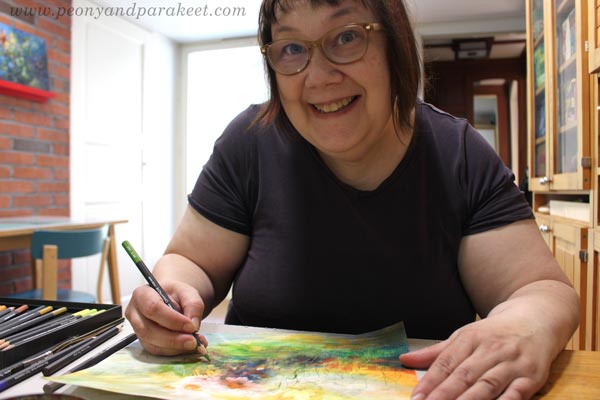
One of the best things about my job is that I can make “comfort drawings” for the blog. So, in the same way that there are comfort books, or comfort food, or comfort music, you can also make comfort drawings.
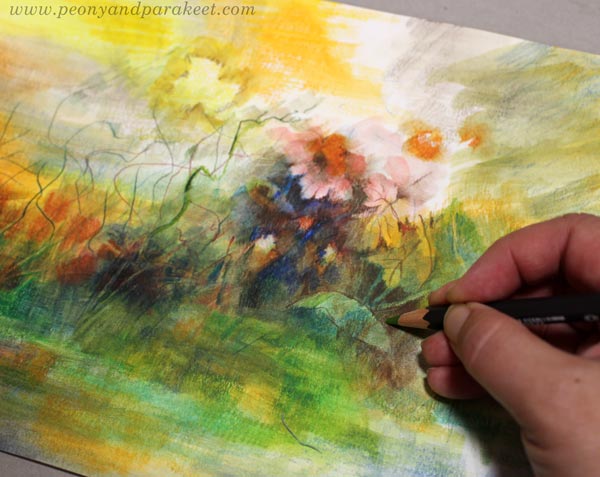
You can let colored pencils take care of all worries and unnecessary thoughts. Float in the sunshine and focus on everything beautiful!
Filling the Desert
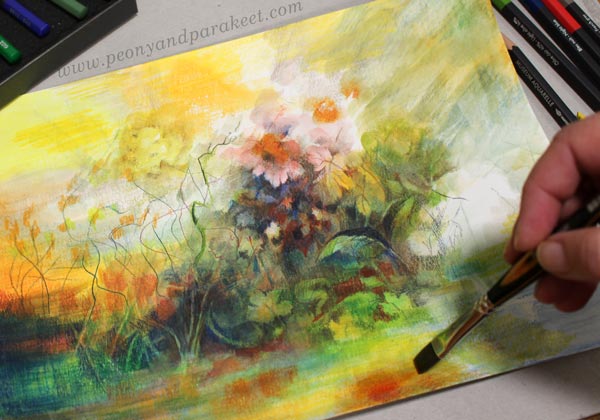
I like to start a drawing with a scenery, which I then fill. This method is also taught in the course Joyful Coloring.
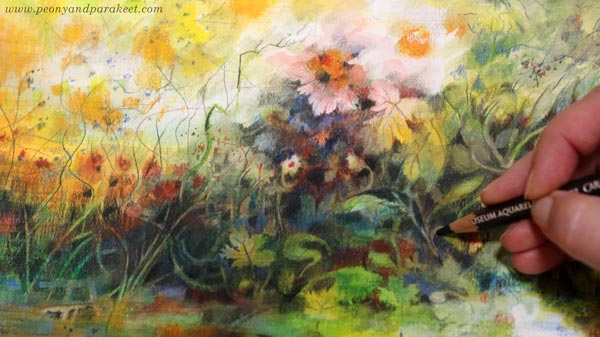
When immersing in the details, you can enjoy the fact that the world shrinks into a tiny area. I think that everything great and wonderful starts small. When thoughts decrease, possibilities expand. Then it is easier to invent and learn new things.
Meadow is a Town
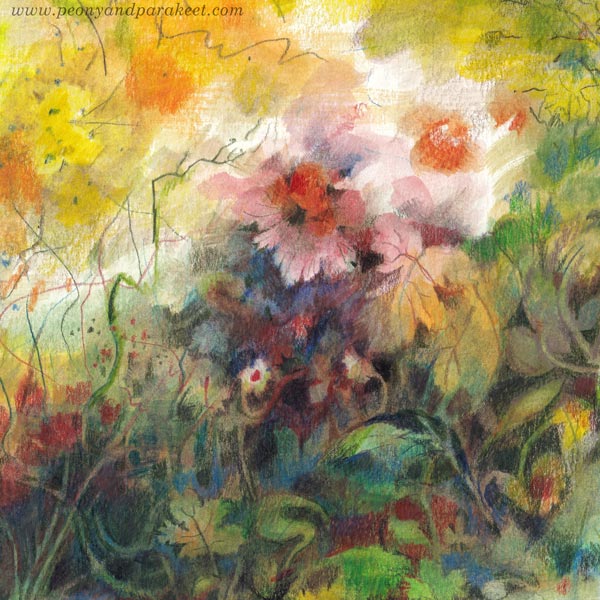
I have looked at the last flowers of summer and admired their details. It’s amazing how much there is in a small meadow flower: stems, seedcases, and flowers and leaves in different stages. And when you multiply those, the group of plants forms a busy town. A meadow is like an upright map of intersections, stations, and roads that guide the bees.
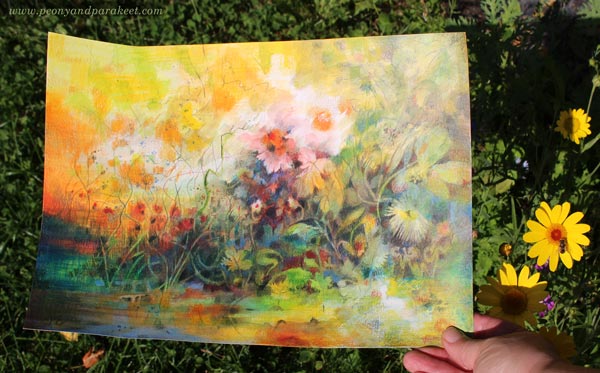
Colors of this kind of world are coming and going. Nothing is permanent and yet everything is so comforting and full of life.
Joyful Coloring – Sign up Now!
The new course Joyful Coloring begins on Sept 16!

Get your watercolor pencils and join me to create freely with joy and sunshine! >> Sign up now!